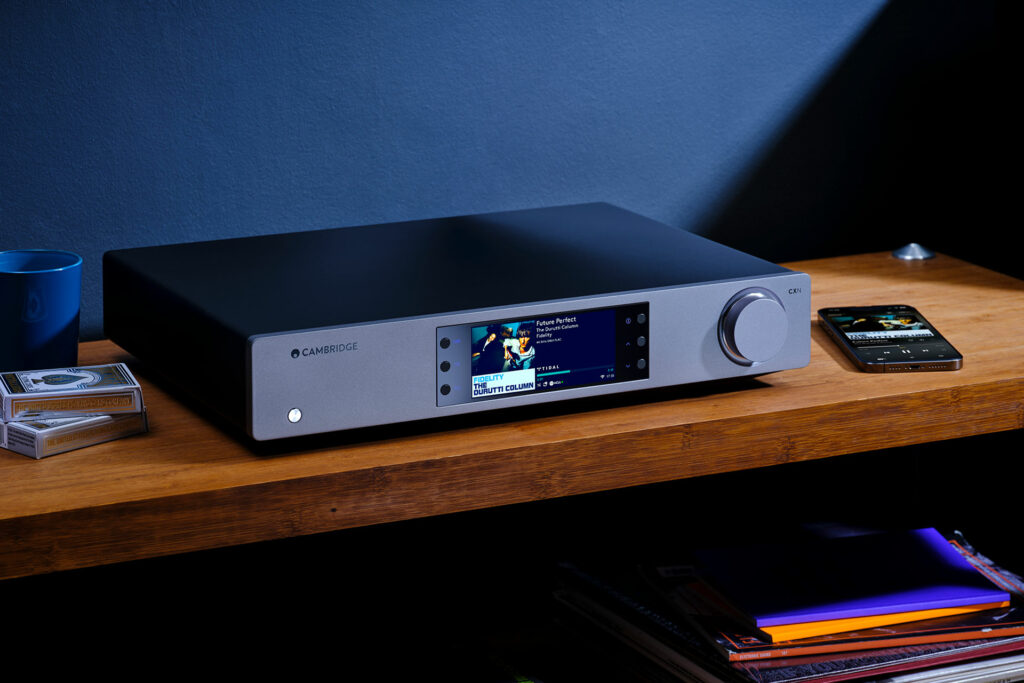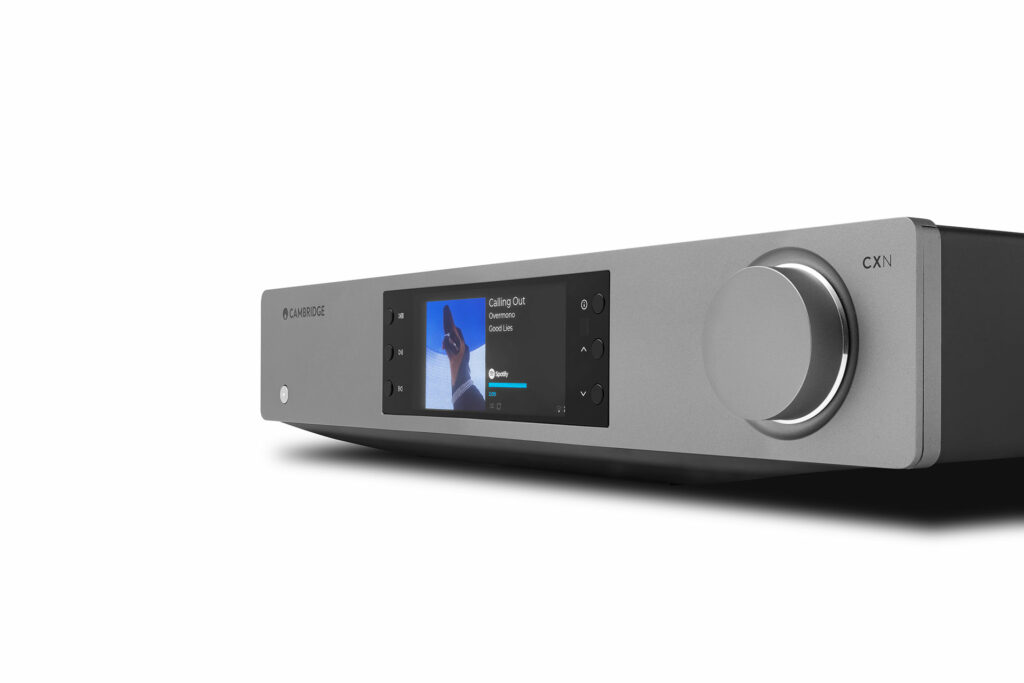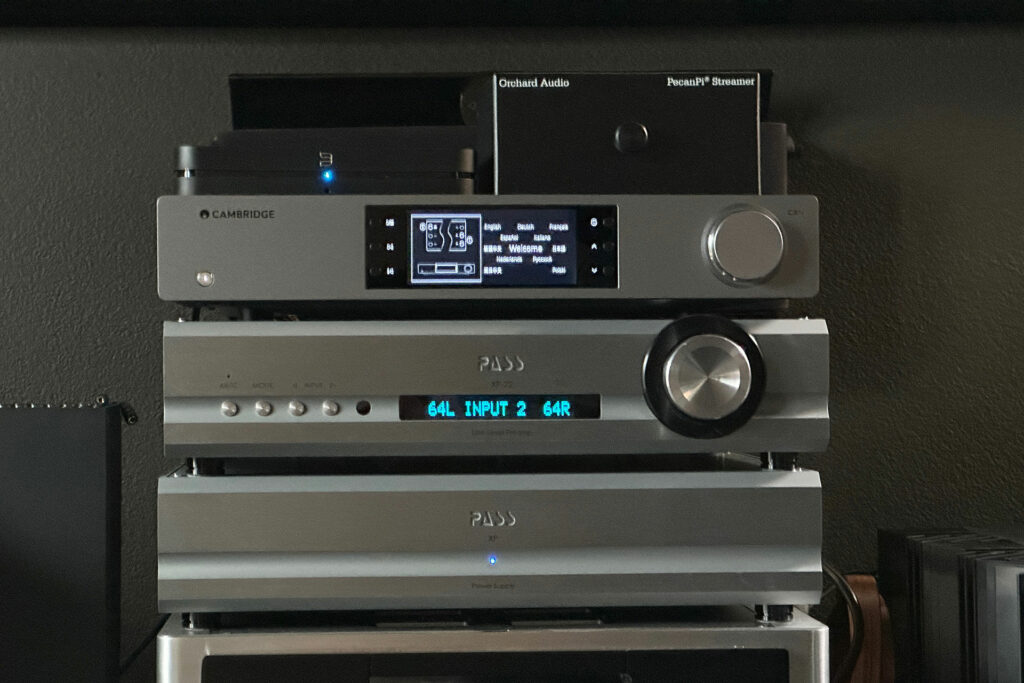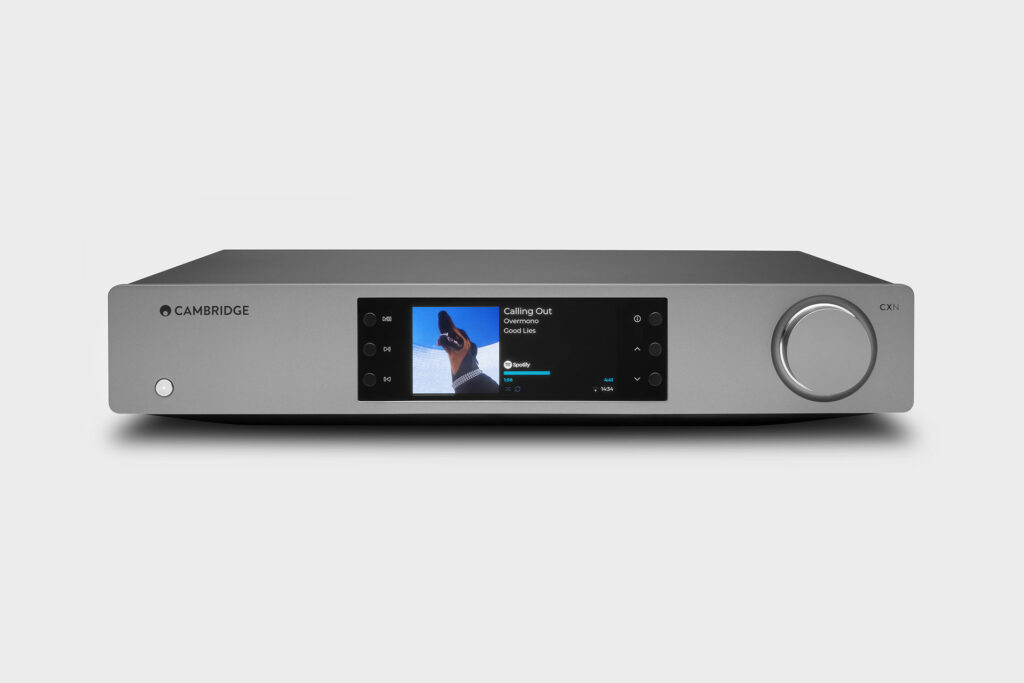Cambridge Audio has a 50-year legacy of designing and producing high-performance audio components with a high-value proposition over 10 years in music streaming electronics. It has become quite popular in recent years. To keep up with a vast amount of new competition entering the streaming DAC product category (streamer plus digital to analog converter), Cambridge Audio introduces the CXN100. The CXN100 is a replacement of the CXNV2 streaming DAC, with a ground-up rebuild, at a retail price of $1,099, and is the topic of this review.
Old and new competitors are entering their best versions of streaming DACs with outrageous features and form factors to disrupt the status quo. Let’s take a deep dive into the Cambridge Audio CXN100. At the same time, I will put it through its paces during the audio listening phase to see if this British audio manufacturer’s Network Player lives up to the competition and Cambridge Audio’s reputation and heritage.

What Makes the Cambridge Audio CXN100 Network Player So Special?
- The CXN100 analog output is designed to connect directly to your preamplifier or stereo preamp/processor through its balanced XLR or unbalanced RCA analog outputs. Additionally, the CXN100 does not up-sample the digital signal at the analog outputs, which audiophile purists appreciate.
- With its digital volume control, the CXN100 can also be a preamplifier by connecting directly to your audiophile amplifier(s).
- The Cambridge Audio CXN100 is a ground-up rebuild of the CXNV2, with upgraded audiophile DACs (ESS 9028Q2M), components, circuitry, signal path, and the newer Gen 4 StreamMagic module.
- The Cambridge Audio Gen 4 StreamMagic module includes hardware and software for music data file processing, music services integration, music management, and the StreamMagic mobile App. Cambridge Audio will maintain firmware updates to StreamMagic online for the most recent features. StreamMagic is Roon-ready and includes streaming service integrations from Qobuz, Tidal, and Deezer. Internet radio is also built in and works without a subscription.
- Tidal Connect and Spotify Connect integrations provide streaming outside of the StreamMagic App, allowing consumers to use the familiar native app of either of these two streaming services for music selection and playback control.
- WiFi and wired Ethernet for Internet connectivity provide flexibility. Airplay 2, Chromecast, and Bluetooth 5.1 are also available for consumer connectivity convenience.
- Digital inputs include S/PDIF Coaxial, and Toslink, which allow the CXN100 to act as a standalone DAC. USB Audio 2.0 PCM up to 32-bit and 768kHz, DSD up to x512. It is worth pointing out that the CXN100 will accept DSD files in their native format up to x512 without conversion to a PCM signal through USB Audio 2.0 input, which is important for those purchasing music downloads in that format.
- Digital outputs include S/PDIF coaxial 16- to 24-bit, 32 to 192kHz PCM and DoP64, Toslink 16- to 24-bit 32-96kHz PCM and DoP64.
- A physical remote control is available through the Cambridge Audio website, but is not included in a standard purchase.
- A six-inch-wide high-resolution color display provides a stellar form factor, while displaying album art, file format, and other relevant information. It is front and center on the CXN100’s full-width chassis. It is not a touchscreen, but rather uses six buttons, three on each side of the screen, to navigate the menu.
- The fit and finish of the Cambridge Audio CXN100 is very good, easy on the eyes, and maintains the CX product series facia.
- The Cambridge CXN100 is designed in England and manufactured in China in a long-established partnership factory, to provide high value.
- The Cambridge Audio CXN100 was easy to connect, and operated flawlessly, while being lightning-fast.
Why Should You Care About the Cambridge Audio CXN100 Network Player?
While streaming music has been around for a while, introducing it into your high-end rig with promises of high-end performance has been relegated to mostly expensive options. Sure, there have been low-price offerings, including some good ones like the BlueSound Node (read the review), but the performance was dodgy, the form factor was dismal, or perhaps both. It is not unusual to see a price tag of $3,000 or more for a high-performing dedicated streamer/DAC with looks that could kill. However, in the last two years, the trend has become higher-performance, focusing on color displays and refined casework at attainable pricing. The Cambridge CXN100, with a $1,099 price tag, is an excellent example of this evolution, as it checks all the boxes that higher-priced components rely upon to differentiate and justify their higher prices. Combine Cambridge Audio’s 50-year legacy, 10 years of streaming experience, and an international dealer network, and you have a compelling product.

Some Things You Might Not Like About the Cambridge Audio CXN100 Network Player …
- One feature I have started to appreciate with Network transports (streamers) and players alike is an HDMI video output of the user interface, album art, and track information to your television screen. Think Roku or Apple TV 4K. While an HDMI output is not typical for music transports or players, I am starting to see their emergence. It is quite the crowd-pleaser when guests can see artists and track information on the big screen. Unfortunately, the CXN100 has no video output. Of course, the user interface shows through the mobile app on a tablet or mobile phone and the color display.
- The Cambridge Audio CXN100 lacks a few valuable connections as a preamplifier: an HDMI input, subwoofer output, and wired headphone output. Such connectivity would expand its utility as an entry-level preamplifier.
- An I2S digital output, not provided on the Cambridge Audio CXN100, is a higher standard of digital output offered on some competing streaming DACs. The I2S output standard uses an HDMI connector and works with an HDMI cable, but is purely a digital audio output to a DAC with an I2S input. Including such an output would allow connectivity to more sophisticated outboard DACs today and in the future.
Listening to the Cambridge Audio CXN100 Network Player …
The Cambridge CXN100, with its XLR analog outputs, connected to my reference system, which consists of a Pass Labs XP 22 preamplifier, wired to a set of Pass Labs XA60.8 high-current monoblock amplifiers, operating in full Class-A mode up to 60 watts at eight ohms, doubling power at four ohms, and again at two ohms. Bowers & Wilkins 805 D4 stand-mounted speakers and Focal Kanta No. 2 floorstanding speakers will provide some variety for the CXN100. The system benefits from Wireworld Eclipse 8 speaker cables, interconnects, and Electra 7 power cables for the amplifiers.
Through the Cambridge Audio StreamMagic App, I played the Dave Matthews song “Crash Into Me” from Qobuz (16 bit/44.1kHz FLAC), with the 805D4s to hear Matthews’ voice, as well as the arrangement of acoustic and electronic instruments. First, the StreamMagic App was straightforward and intuitive, more so than other apps I have worked with. I had both Tidal and Qobuz streaming accounts set up in the StreamMagic app, and it was easy to select between the two services. I am sure everyone has their way of choosing music, but I follow the path of the recording artist, then the music track, since I know what I want to listen to for a given product review. StreamMagic made it easy to engage the music in that manner, and it was lightning-fast between tracks.
The audio image was large, with excellent depth behind and in front of the speakers, creating a significant soundstage. The image was forward just enough to engage me without any sonic fatigue. The detail in instrumentation and vocals was remarkable. Matthews’ voice was effortless and smooth, yet carried the natural grit you would typically expect in his songs but do not hear on average audio equipment; the emotional conviction of his lyrics rang through the track exceptionally well. At lower volumes, the midrange still had weight and a good amount of bass, although not as much at louder levels, which is normal. The Bowers and Wilkins 805 D4 is very detailed on the upper frequencies, getting closer to a live sound, and the CXN100 took advantage of that capability with excellent detail and clarity. The Focal Kanta No. 2s’ higher frequencies were smooth yet clear and concise, without drawing attention to themselves. Additionally, the Kantas provided a full range of bass, which I expected. Ultimately, it is a personal preference, but it was great to hear the CXN100 work well with both speakers, showing their individual characteristics. Overall, it was a balanced presentation close to but better than the Bluesound Node, which I had on hand to compare directly. The CXN100, compared to the Node, has a more natural quality to vocals with better realism and less fatigue. It is not dramatically different, but it is noticeable. At the time of my Eversolo DMP A6 review, I compared it to the Bluesound Node and felt they both had similar qualities, suggesting the CXN100 has a leg up on the DMP A6.
Next was Bruce Hornsby’s “The Way It Is” through StreamMagic and Qobuz (24-bit/44.1kHz FLAC) to hear how the CXN100 would render Hornsby’s voice and piano. The vocals sounded incredibly smooth and effortless, giving Hornsby his trademark sound. At the same time, the piano performance had an authentic tenor that was non-fatiguing with a good amount of heft, just forward enough to hover in front of my listening area. It was easy to forget about the audio gear while enjoying the performance and recalling when this track was released. With the CXN100, I was reminded of Hornsby’s admirable vocal range. The image was impressive, with Hornsby’s voice centered slightly off-center to the right and at the correct height, and the rest of his ensemble falling into place, clear and crisp, musical, and all-around pleasing. I toggled between Tidal (24-bit/44kHz MQA) and Qobuz a few times, and came away with Qobuz as the winner: subtle nuances with the piano sounded more realistic. The difference was not dramatic but discernable to a trained ear side by side. Again, the comparison was within the StreamMagic app.
“Stand by Me” by The Pretenders provided an opportunity to hear a British rocker, streamer, and speakers, with the Bowers & Wilkins in place. The CXN100 would render Chrissy Hynde’s swanky female voice as smooth as glass, with transparency showing off Hynde’s edgy style. Of course, imaging continued to shine with an appropriate width and depth. In my system, I could hear Hynde’s vocals at just the right height, centered nicely between my speakers. When I changed out the Bowers & Wilkins D4s and added some France to the mix with the Kanta No. 2s, the Cambridge CXN100 took advantage of the more profound bass response of the full-range Kantas with an impressive image and soundstage presentation. Once again, the CXN100 proved it could exploit both speakers’ characteristics.
With each artist and music track referenced here, and with the Focal speakers, I reconnected the CXN100 directly to the amplifiers and set the streaming DAC to variable output, thereby engaging the digital volume control. Neither the top nor the low end was as supreme, and an opaque layer prevented clarity from passing through, compared to when the Pass Labs XP22 preamplifier was connected. I was not surprised by the higher audio quality with a 10k preamplifier in the signal path. Still, I was disappointed that the CXN100 did not reach a higher level of transparency. According to the Cambridge Audio website, digital volume control is performed within the ESS 9028Q2M DAC chip, which includes an up-sampling feature for volume control if engaged. However, I have heard volume control from DACs with an ESS chip, and I felt it performed better. The Bluesound Node uses a Texas Instruments DAC chip and volume, which outperforms the CXN100. The chip alone may not be the issue, but rather its implementation of that feature. The bottom line is that preamplifier volume control is not the CXN100’s best attribute.
Another test was using Tidal Connect and the Tidal native app, circumventing the StreamMagic app. With the XP22 preamplifier back in place, I toggled back and forth between the StreamMagic app and Tidal Connect with these same songs and could not discern any tangible differences. As of this writing, Tidal is still streaming in MQA (which is changing to high-resolution FLAC) on many tracks, and with the Dave Matthews Band track “Crash.” Per the CXN100 manual, I could receive a green or blue dot next to the MQA identifier on the front display. Green means the stream is an MQA file, while blue signifies that the CXN100 received a studio-quality original track, which is what was playing for this song. Lastly, Tidal Connect allowed navigation within the familiar Tidal app. All around, clarity, imaging, and soundstage continued to impress.
Airplay 2 allowed me to connect the Apple Music app to the CXN100 from my iPhone 14. As I have experienced, Airplay 2 does not provide optimal performance, and a similar experience happened here. Through Qobuz and Tidal along with the aforementioned tracks, Airplay 2 changes the file format to either AAC or ALAC. Audio quality was inferior in all cases, with a lack of clarity, and lower dynamic range. While AirPlay 2 works well enough in a car environment, its weaknesses were evident through my high-resolution system, where flaws are easily exposed. Aside from the file type change, the issue with Airplay 2 is that the stream is from the phone to the CXN100 DAC section, instead of the CXN100 performing streaming duties. In contrast, with StreamMagic or Tidal Connect, the CXN100 performs the streaming task from your music subscription directly, with the iPhone acting as a remote control, which is an important distinction.

Will the Cambridge Audio CXN100 Network Player Hold Its Value?
As mentioned earlier, streaming technology is still a relatively newer audio source for high-end systems, especially for units with an attainable price point like the Cambridge Audio CXN100, and this product category will continue to evolve. As streaming technology improves, all streamers will lose value, but until then, the value proposition of the Cambridge CXN100, with its form factor, feature set, and attainable price point, strikes a unique balance. It should hold its value more than the average streaming DAC.
What is the Competition for the Cambridge Audio CXN100 Network Player?
The Volumio Primo is a Network Player (streamer and DAC) designed and assembled in Italy, which can be ordered online directly from their website for $1,099. I included the Volumio Primo, since it hits the same price with a similar feature set as the CXN100. However, the Primo has a different form factor than the CXN100, since it lacks a screen and the status of a full-size component. Depending on your preferences, this may be fine, since the Primo sports a unique physical appearance with its distinctive Italian casework. Additionally, the Primo addresses its missing screen with an HDMI output for displaying the user interface to your monitor, which is helpful in a media room with a video display. Digital outputs include coax and AES/EBU for PCM high-resolution 24-bit/192kHz output. A USB output supports PCM up to 32-bit at 768kHz and DSD256 (DSD DAC required). The Premium version of the company’s Volumio OS is included, and integrates Spotify, Tidal, and Qobuz, and is Roon-ready. Wireless and wired Internet connectivity is available. AirPlay and Bluetooth 5.0 are supported. I have yet to audition the Primo, so I cannot comment on how well it performs compared to the Cambridge CXN100, but its specifications are intriguing, and it is in line for review.
The BlueSound Node (buy at Crutchfield) is a worthy competitor at $499. With many features and good performance, it is worthwhile to consider if you want to save money, and prefer a minimalist aesthetic. The Node is understated and can be hidden in a rack or cabinet. A design like this has no room for a screen. The lack of balanced analog outputs (RCA outputs only) may concern some. On the plus side, the Node has integrations with 21 different streaming services. However, you only need one music service integration, which is the integration of your streaming service. Most consumers start with a streaming service, stay with it, and do not maintain multiple services. And remember that both Spotify and Tidal are almost always supported by the Connect feature, circumventing the need for proprietary music app integration. While the Node is venerable, I would splurge for the Cambridge CXN100’s better audio quality, color display, balanced analog outputs, and better form factor. However, that is my opinion, given my tastes and needs. Your budget and priorities may be different.
A YouTube community favorite mentioned in this review, the Eversolo DMP A6 (read the review) at $859, is another competitive player worth noting. While it does not have the Cambridge 50-year heritage, it has an impressive feature set, build quality, and form factor worth noting. This product has put many established audio companies on notice and elevated the status quo. You can read the review of the DMP A6 here, but in short, during my experience, it had a similar sound to the Bluesound Node, which means a bit inferior to the CXN100 – when used as a source, not a preamplifier. I believe the StreamMagic app flow is more intuitive and easier to use. However, the Eversolo has many features and functions that the Cambridge Audio CXN100 lacks.
The Orchard Audio Pecan Pie+ Premium, at $1,499, has a similar form factor to the CXN100 with a touchscreen color display. It uses the highly respected AKM chipset, Orchard Audio’s proprietary jitter reduction circuitry, and quality part selection. I reviewed the standard Pecan Pie+ in a head to head battle with the Bluesound Node and Eversolo DMP A6, with the Pecan Pie+ reigning supreme. The Orchard Audio Pecan Pi+ Premium has the same internal workings, with the addition of a touch panel color screen and more esteemed casework. Consider this network player if spending an extra $400 is an option.

Final Thoughts on the Cambridge Audio CXN100 Network Player …
Like many things in life, it is hard to be all things to all people. Audio components are no different: there will always be tradeoffs. The Cambridge Audio CXN100 Network Player is an excellent component with commendable performance when used as a streaming DAC connected to an outboard preamplifier. It struggles when used as a preamplifier streaming DAC. As a source, I found the CXN100 to be a high performer. On one hand, the CXN100 is geared toward the audio enthusiast looking for high-end sound quality as a streamer DAC. On the other hand, it offers some creature comforts ordinary consumers will benefit from. But it depends on your needs, and how you build your system. The form factor alone is intriguing, and adding this gem to a short list of network players at the $1k-plus/minus price point is easy when considering its feature set and functionality. For existing Cambridge Audio CX line customers looking to maintain a homogenous appearance while embedding music streaming into their audio system routine, the CXN100 earns your consideration. Overall, the Cambridge CXN100 is a highly impressive and compelling network player.




It seems Cambridge is really making some cutting-edge products these days. This may be a little off topic, but I hope futureaudiophile will review the Cambridge Evo ONE. Seems like another interesting and well-designed product from Cambridge that merits a review.